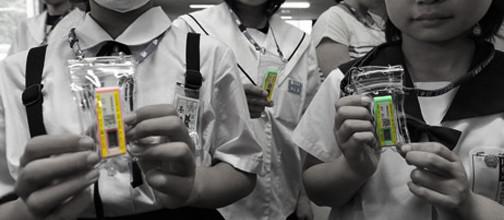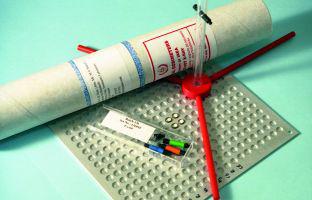Going postal: When radiation dosimeters got into a box
Author:
Maria Rentetzi is associate professor of history and sociology of science and technology at the National Technical University of Athens in Greece. She received her B.Sc. in Physics at the University of Thessaloniki, an MA in History and Philosophy of Science and Technology (NTUA) and a second MA in Philosophy (VT). She completed her PhD in Science and Technology Studies at Virginia Tech. Her main research interest is the material culture of radioactivity. Her latest forthcoming book Radium Economies (Yale University Press) explores radium as both a precious commodity and a scientific object of the early 20th century U.S. With her ongoing exhibition Καπνός | Tabak, Rentetzi investigates also the materiality in historical studies of tobacco technologies in 20th century Greece.
What is a radiation dosimeter? Why do we need one? To give you an interesting and short response I will remind you what the Japanese government officials offered to Fukushima evacuees after the 2011 nuclear disaster. Having failed to reach their original radiation decontamination target, the government proposed that evacuees could return to their homes taking responsibility of their own safety. “The residents called for continued clean-up efforts, but government officials offered them dosimeters instead” revealed Miki Aoki of The Asahi Shimbun, one of the country’s national newspapers 1. Dosimeters were actually transforming public concerns over radiation safety to issues of personal responsibility.

Dosimeters are measurement devices designed to detect invisible radiation. Since the mid-1950s the protection of public health from the consequences of exposure to ionizing radiation has been indeed a key research topic and, at the same time, a major source of controversy. Both the hazards of the radiation released by nuclear power plants and the increasing use of radiation technologies for cancer treatments arouse public anxiety. In April 1960 a scientific team from the Oak Ridge National Laboratory under the directorship of the well-known physicist, Karl Ziegler Morgan, joined the newly founded International Atomic Energy Commission in an experiment that proved to be both unique and important in the history of dosimetry. The joint project sought to shed light on the relationship between the exact radiation doses received and the clinical effects that were observed in an accident that took place at the Vinca Nuclear Institute near Belgrade in 1958. An uncontrolled run of the institute’s reactor in October that year resulted in six workers receiving high radiation doses. They all developed severe radiation sickness and one died. Within a period of treatment in Belgrade and then at the Curie hospital in Paris, the five survivors received experimental bone marrow transplants before they finally all rejected them.
The Vinca accident proved to be important because the efforts to determine the doses received by the six workers revealed the need for improved means of dosimetry. The relevant data were scarce and thus precious in studying the relationship between levels of radiation and their effects on people. A couple of months after the experiment, the IAEA organized a meeting in Vienna with leading scientists from 33 countries to discuss issues regarding radiation dosimetry. In his closing speech, Sterling Cole, the ranking US Congressman who agreed to head the Agency during its formative years, emphasized the importance of advancing knowledge in the field of radiation dosimetry. He made clear that the Agency would take appropriate action to help meet this need, which it actually did. It was in that year, according to Horst Eisenlohr, later head of the Dosimetry Section, that the IAEA’s Dosimetry Laboratory was formally set up. The physicist Johann Nagl was appointed as its head2.
One of the earlier Nagl’s tasks was to design and construct an absorbed dose calorimeter and test a system suitable for a postal dose comparison service. Satisfying the global need to calculate radiation doses meant designing a portable dosimeter. In 1965 Nagl and the physicist Alexander Sanielevici who had previously worked at Curie’s lab in Paris, organized the first trial postal dose comparison for electron beams using the Fricke dosimeter. A kind of chemical dosimeter, the Fricke, contained a corrosive liquid in unsealed containers and could not be easily transported, especially by air3. Its main disadvantage was the fact that it was not mobile.
The next year the IAEA embarked on a more systematic investigation in order to set up an intercomparison system among radiotherapy clinics. A new kind of dosimeter was proposed, known as the TLD, which could be more easily transported across the world. Those are small, portable dosimeters produced by dispensing thermoluminecent powder into a tiny plastic tube. These were then sent by the IAEA to medical physicists in hospitals all over the world, simply by post. The medical personnel irradiated the dosimeters to a specific dose and, through the same postal procedure, would send the sample to the Vienna dosimetry lab for readout and analysis. The dose received by the small dosimeter was measured by the IAEA staff and compared with the intended dose stated by the hospital physicists. If discrepancies were detected, further actions were taken in order to reduce and ideally eliminate the possibility that a cancer patient might be irradiated with the wrong dose. The first TLD run took place in 1966 within a few advanced clinics.

By “going postal,”the TLDs linked the IAEA’s dosimetry lab to bodies such as the World Health Organization in the mid-1960s. As a result, a global joint dosimetry audit program was set up making possible the establishment of national networks of hospitals specialized in cancer therapy and of secondary laboratories (SSDL) in Member States for standardizing radiation measurements. In 1970, the IAEA proposed the first international dosimetry protocol. The cornerstone in the laboratory’s history is the creation of a worldwide network of secondary standard dosimetry laboratories under the auspice of both the IAEA and WHO in 1976. Today the TLD postal dose audit service remains the major scientific activity for IAEA’s Dosimetry Laboratory. Interestingly, to resolve discrepancy problems and correct dosimetry at participating institutions is hardly a simple scientific task but often involves complex diplomatic negotiations between the Member State and the IAEA.
What are dosimeters then? They are not just measurement devices, simple portable instruments, and part of the laboratory’s material culture. They are also and foremost regulatory devices constitutive of concepts of public health, safety, and permitted levels of radiation exposure. They get involved in global diplomatic negotiations as long as, by being postal, they travel through the network of the United Nations Member States determining radiation doses and calibrating medical technologies. Dosimeters have never been “purely scientific” but instead a matter of social and political importance. By putting a dosimeter in a box and sending it worldwide, the IAEA sought to standardize radiation dosimetry in nuclear medicine and also to win the confidence and support of the public in its rules and procedures. Going postal meant going global exceeding the confined space of the scientific laboratory.
References
- Aoki, Miki. “Government offers dosimeters—not decontamination—for Fukushima evacuees” The Asahi Shimbun, June 29, 2013 ↩
- Eisenlohr, Horst. “The IAEA/WHO TLD Postal Dose Audit Service: From 1966 to 2010” SSDL Newsletter, 58: 2010, 11-12. ↩
- Soares Christopher G., Eric L. Bright, and Margarete Ehrlich 1987. Fricke dosimetry in high-energy electron beamsGaithersburg, MD : U.S. Dept. of Commerce, National Bureau of Standards. ↩
1 comment
[…] Read the rest here: Going postal: When radiation dosimeters got into a box | History … […]